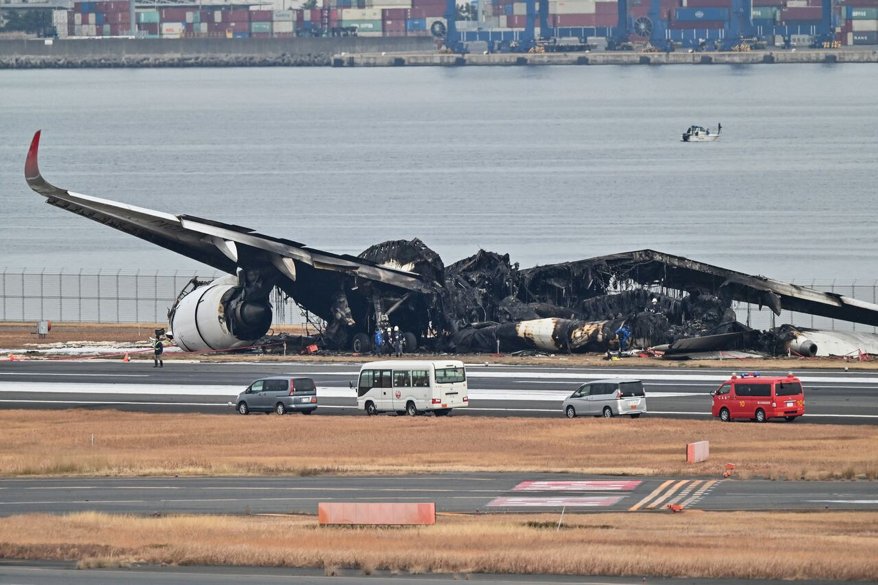Japan Airlines’ A350 Collision: A Crucial Test for Carbon Composite Aircraft in Fire Emergencies

The recent runway collision at Tokyo’s Haneda Airport involving a Japan Airlines (JAL) Airbus A350 has placed a spotlight on the resilience of modern carbon-composite aircraft (Airbus A350, Boeing 787, 777-8 and 777-9) in catastrophic fire scenarios. This incident, which marks the first major destruction of a lightweight airliner by fire, is being closely observed as a critical test case for the new generation of high-tech composite airplanes.
The JAL Airbus A350-900, colliding with a De Havilland Dash-8 coast guard turboprop plane, burst into flames shortly after landing. Despite the severe circumstances, all 379 people aboard the A350 were successfully evacuated, though tragically, five out of the six coast guard crew members perished.
The aviation industry is now keenly focused on how these advanced composite airliners, which have revolutionized long-haul flights and airline economics over the past decade, withstand catastrophic fires. Investigators are currently probing the cause of the collision, with the aviation community awaiting insights into the survivability and durability of these high-tech planes in extreme conditions.
Japan Airlines Evaluates Impact of Tokyo Plane Crash
The incident presents a unique case study, not only regarding fire safety but also crash survivability, according to Anthony Brickhouse, an air safety expert at Embry-Riddle Aeronautical University. Both Boeing with its 787 Dreamliner and Airbus with the A350 have heavily invested in lightweight carbon composites, betting on significant fuel savings and reduced maintenance due to less susceptibility to fatigue.
Previous incidents, such as the battery problems on the Dreamliner leading to fires and brief grounding in early 2013, did not result in hull losses. The A350, composed of 53% composite materials by weight, has its external structure, including the fuselage, major tail and wing sections, and part of the nose, primarily made of these materials.
Experts highlight that the safe evacuation of passengers and crew while the aircraft’s structure remained intact could boost confidence in composite materials, despite it being too early for conclusive assessments of the A350’s composite hull’s performance in the fire.
Understanding Composite Aircraft and Fire Safety
Comparing this crash to the 2013 Boeing 777 incident involving Asiana Airlines, where a fire broke out post-collision, could offer valuable insights into how composite and aluminum planes react differently in fires, Brickhouse notes.
The JAL A350 is the first primarily composite-built commercial airliner to be destroyed by fire. However, similar incidents, like the 2015 crash of an Airbus A400M military airlifter heavily reliant on composites, provide limited data due to confidentiality in investigations.
Composites vs. Aluminum: A Safety Perspective
Composite airframes, as explained by Bjorn Fehrm, a composites expert at Leeham News, offer several advantages over traditional aluminum planes. For instance, carbon fiber can withstand significantly higher temperatures, smoldering and burning away rather than melting. Airbus has previously indicated that the A350 demonstrates “an equivalent level of safety” compared to aluminum planes, showing “increased resistance” to fire penetration.
However, prolonged exposure to intense heat can compromise the structural integrity of composite airframes, even if the outer skin appears unscathed. The lengthy duration of the JAL A350 fire, lasting over six hours, raises questions about whether special firefighting techniques are required for composite jets.
Implications for Firefighting and Aircraft Design
This incident highlights the need for potentially reevaluating firefighting approaches at airports and understanding the flammability of composites, considering various factors like structure, fiber materials, and fire-blockers. As the investigation continues, the aviation industry eagerly awaits insights that could further inform the safety and design of future aircraft.
Sources: AirGuide Business airguide.info, bing.com, insurancejournal.com
